Influence of Serial Position Effect on Short-Term Memory: A Quantitative Research Report
VerifiedAdded on 2023/06/08
|13
|2385
|301
AI Summary
This study outlines the influence of serial position effect on short-term memory. It compares the results of the study with the original scripts and through replication of other study based on this hypothesis. The word lists provided by the students as what they remembered is compared with the original list from the lecturer. The study involved several logical steps that were followed in order to satisfy the required standards for research. The results indicate a close relativity between the study and the past results of different activities of research on the topic of serial position effect on short-term memory.
Contribute Materials
Your contribution can guide someone’s learning journey. Share your
documents today.

Running head: Quantitative research Report 1
Quantitative research report
Student's Name
University Affiliation
Quantitative research report
Student's Name
University Affiliation
Secure Best Marks with AI Grader
Need help grading? Try our AI Grader for instant feedback on your assignments.
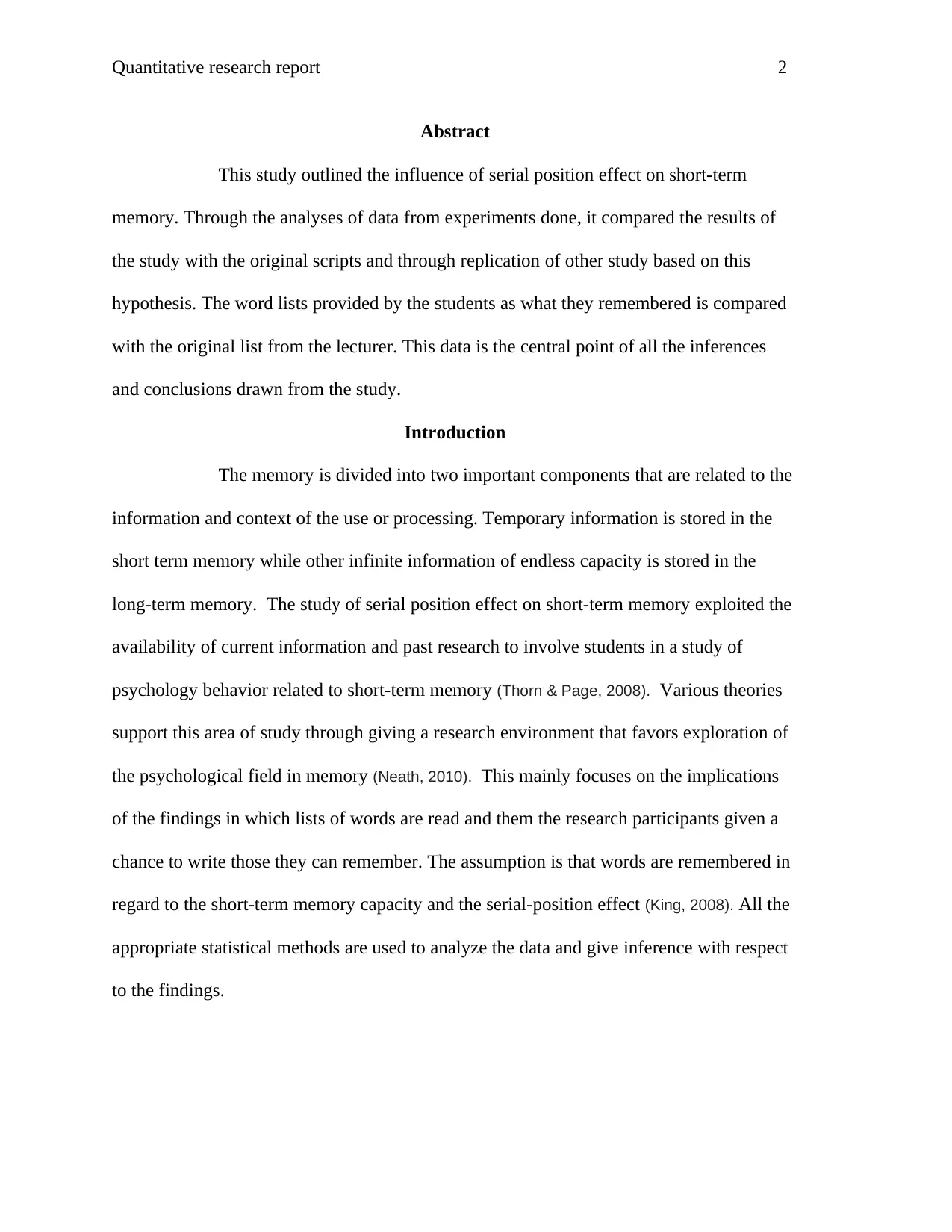
Quantitative research report 2
Abstract
This study outlined the influence of serial position effect on short-term
memory. Through the analyses of data from experiments done, it compared the results of
the study with the original scripts and through replication of other study based on this
hypothesis. The word lists provided by the students as what they remembered is compared
with the original list from the lecturer. This data is the central point of all the inferences
and conclusions drawn from the study.
Introduction
The memory is divided into two important components that are related to the
information and context of the use or processing. Temporary information is stored in the
short term memory while other infinite information of endless capacity is stored in the
long-term memory. The study of serial position effect on short-term memory exploited the
availability of current information and past research to involve students in a study of
psychology behavior related to short-term memory (Thorn & Page, 2008). Various theories
support this area of study through giving a research environment that favors exploration of
the psychological field in memory (Neath, 2010). This mainly focuses on the implications
of the findings in which lists of words are read and them the research participants given a
chance to write those they can remember. The assumption is that words are remembered in
regard to the short-term memory capacity and the serial-position effect (King, 2008). All the
appropriate statistical methods are used to analyze the data and give inference with respect
to the findings.
Abstract
This study outlined the influence of serial position effect on short-term
memory. Through the analyses of data from experiments done, it compared the results of
the study with the original scripts and through replication of other study based on this
hypothesis. The word lists provided by the students as what they remembered is compared
with the original list from the lecturer. This data is the central point of all the inferences
and conclusions drawn from the study.
Introduction
The memory is divided into two important components that are related to the
information and context of the use or processing. Temporary information is stored in the
short term memory while other infinite information of endless capacity is stored in the
long-term memory. The study of serial position effect on short-term memory exploited the
availability of current information and past research to involve students in a study of
psychology behavior related to short-term memory (Thorn & Page, 2008). Various theories
support this area of study through giving a research environment that favors exploration of
the psychological field in memory (Neath, 2010). This mainly focuses on the implications
of the findings in which lists of words are read and them the research participants given a
chance to write those they can remember. The assumption is that words are remembered in
regard to the short-term memory capacity and the serial-position effect (King, 2008). All the
appropriate statistical methods are used to analyze the data and give inference with respect
to the findings.
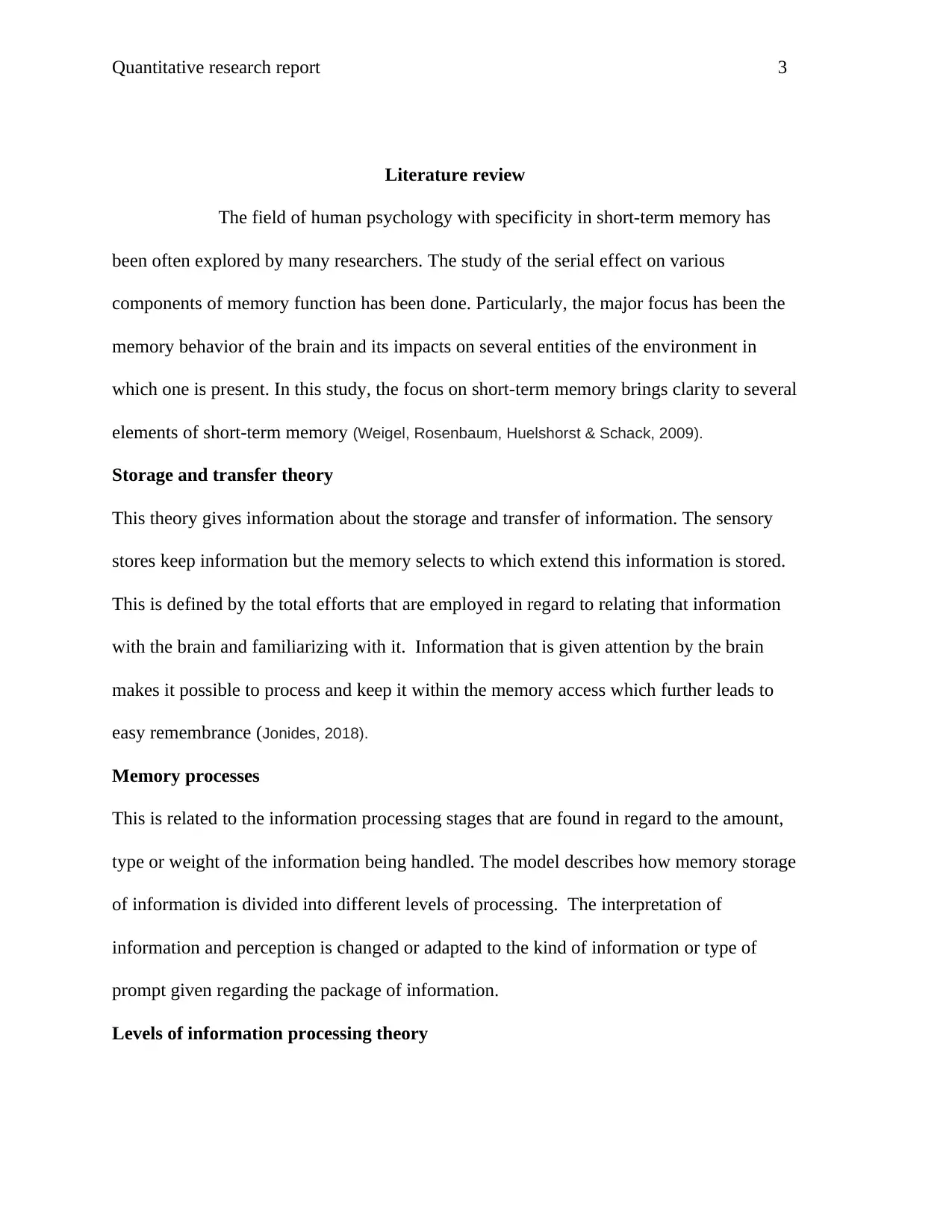
Quantitative research report 3
Literature review
The field of human psychology with specificity in short-term memory has
been often explored by many researchers. The study of the serial effect on various
components of memory function has been done. Particularly, the major focus has been the
memory behavior of the brain and its impacts on several entities of the environment in
which one is present. In this study, the focus on short-term memory brings clarity to several
elements of short-term memory (Weigel, Rosenbaum, Huelshorst & Schack, 2009).
Storage and transfer theory
This theory gives information about the storage and transfer of information. The sensory
stores keep information but the memory selects to which extend this information is stored.
This is defined by the total efforts that are employed in regard to relating that information
with the brain and familiarizing with it. Information that is given attention by the brain
makes it possible to process and keep it within the memory access which further leads to
easy remembrance (Jonides, 2018).
Memory processes
This is related to the information processing stages that are found in regard to the amount,
type or weight of the information being handled. The model describes how memory storage
of information is divided into different levels of processing. The interpretation of
information and perception is changed or adapted to the kind of information or type of
prompt given regarding the package of information.
Levels of information processing theory
Literature review
The field of human psychology with specificity in short-term memory has
been often explored by many researchers. The study of the serial effect on various
components of memory function has been done. Particularly, the major focus has been the
memory behavior of the brain and its impacts on several entities of the environment in
which one is present. In this study, the focus on short-term memory brings clarity to several
elements of short-term memory (Weigel, Rosenbaum, Huelshorst & Schack, 2009).
Storage and transfer theory
This theory gives information about the storage and transfer of information. The sensory
stores keep information but the memory selects to which extend this information is stored.
This is defined by the total efforts that are employed in regard to relating that information
with the brain and familiarizing with it. Information that is given attention by the brain
makes it possible to process and keep it within the memory access which further leads to
easy remembrance (Jonides, 2018).
Memory processes
This is related to the information processing stages that are found in regard to the amount,
type or weight of the information being handled. The model describes how memory storage
of information is divided into different levels of processing. The interpretation of
information and perception is changed or adapted to the kind of information or type of
prompt given regarding the package of information.
Levels of information processing theory
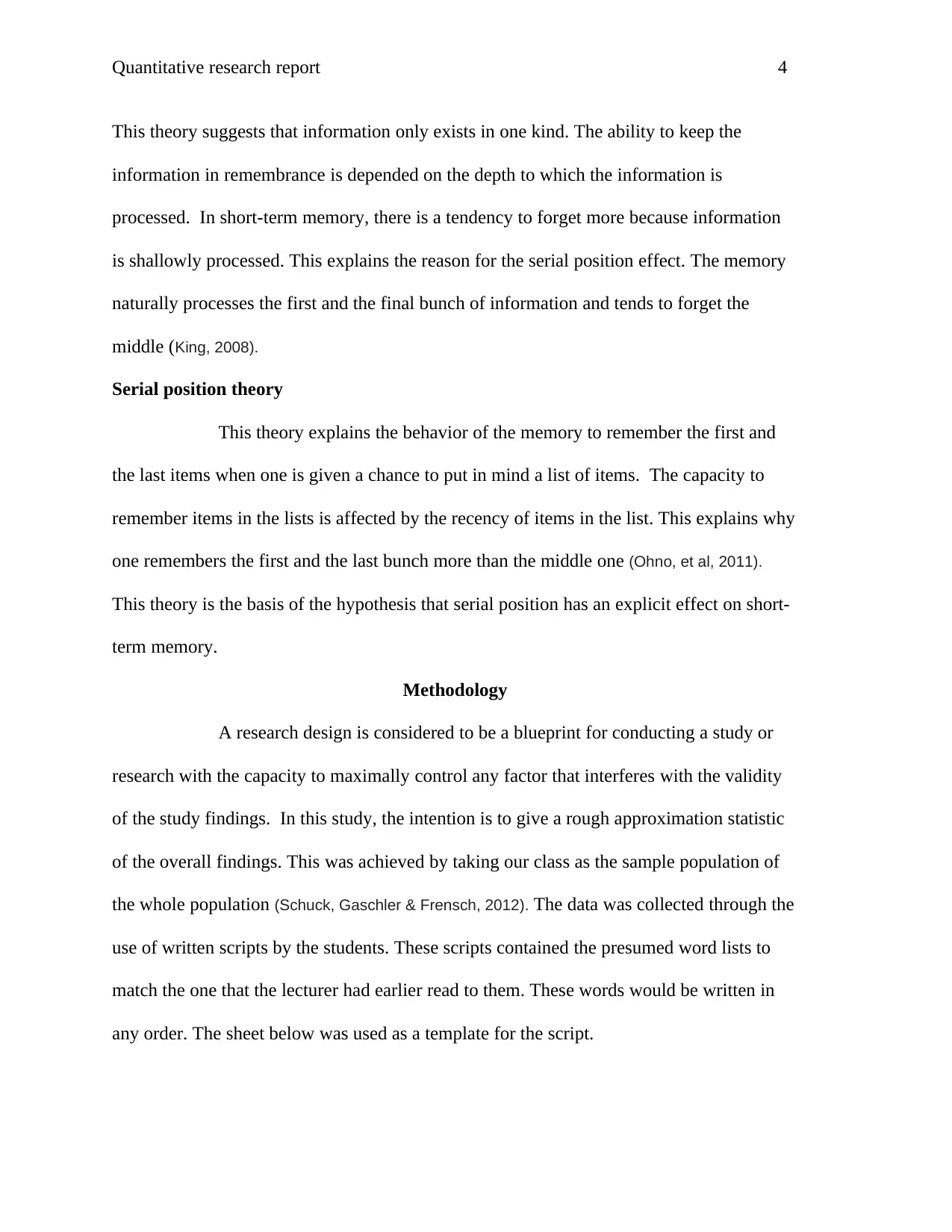
Quantitative research report 4
This theory suggests that information only exists in one kind. The ability to keep the
information in remembrance is depended on the depth to which the information is
processed. In short-term memory, there is a tendency to forget more because information
is shallowly processed. This explains the reason for the serial position effect. The memory
naturally processes the first and the final bunch of information and tends to forget the
middle (King, 2008).
Serial position theory
This theory explains the behavior of the memory to remember the first and
the last items when one is given a chance to put in mind a list of items. The capacity to
remember items in the lists is affected by the recency of items in the list. This explains why
one remembers the first and the last bunch more than the middle one (Ohno, et al, 2011).
This theory is the basis of the hypothesis that serial position has an explicit effect on short-
term memory.
Methodology
A research design is considered to be a blueprint for conducting a study or
research with the capacity to maximally control any factor that interferes with the validity
of the study findings. In this study, the intention is to give a rough approximation statistic
of the overall findings. This was achieved by taking our class as the sample population of
the whole population (Schuck, Gaschler & Frensch, 2012). The data was collected through the
use of written scripts by the students. These scripts contained the presumed word lists to
match the one that the lecturer had earlier read to them. These words would be written in
any order. The sheet below was used as a template for the script.
This theory suggests that information only exists in one kind. The ability to keep the
information in remembrance is depended on the depth to which the information is
processed. In short-term memory, there is a tendency to forget more because information
is shallowly processed. This explains the reason for the serial position effect. The memory
naturally processes the first and the final bunch of information and tends to forget the
middle (King, 2008).
Serial position theory
This theory explains the behavior of the memory to remember the first and
the last items when one is given a chance to put in mind a list of items. The capacity to
remember items in the lists is affected by the recency of items in the list. This explains why
one remembers the first and the last bunch more than the middle one (Ohno, et al, 2011).
This theory is the basis of the hypothesis that serial position has an explicit effect on short-
term memory.
Methodology
A research design is considered to be a blueprint for conducting a study or
research with the capacity to maximally control any factor that interferes with the validity
of the study findings. In this study, the intention is to give a rough approximation statistic
of the overall findings. This was achieved by taking our class as the sample population of
the whole population (Schuck, Gaschler & Frensch, 2012). The data was collected through the
use of written scripts by the students. These scripts contained the presumed word lists to
match the one that the lecturer had earlier read to them. These words would be written in
any order. The sheet below was used as a template for the script.
Secure Best Marks with AI Grader
Need help grading? Try our AI Grader for instant feedback on your assignments.
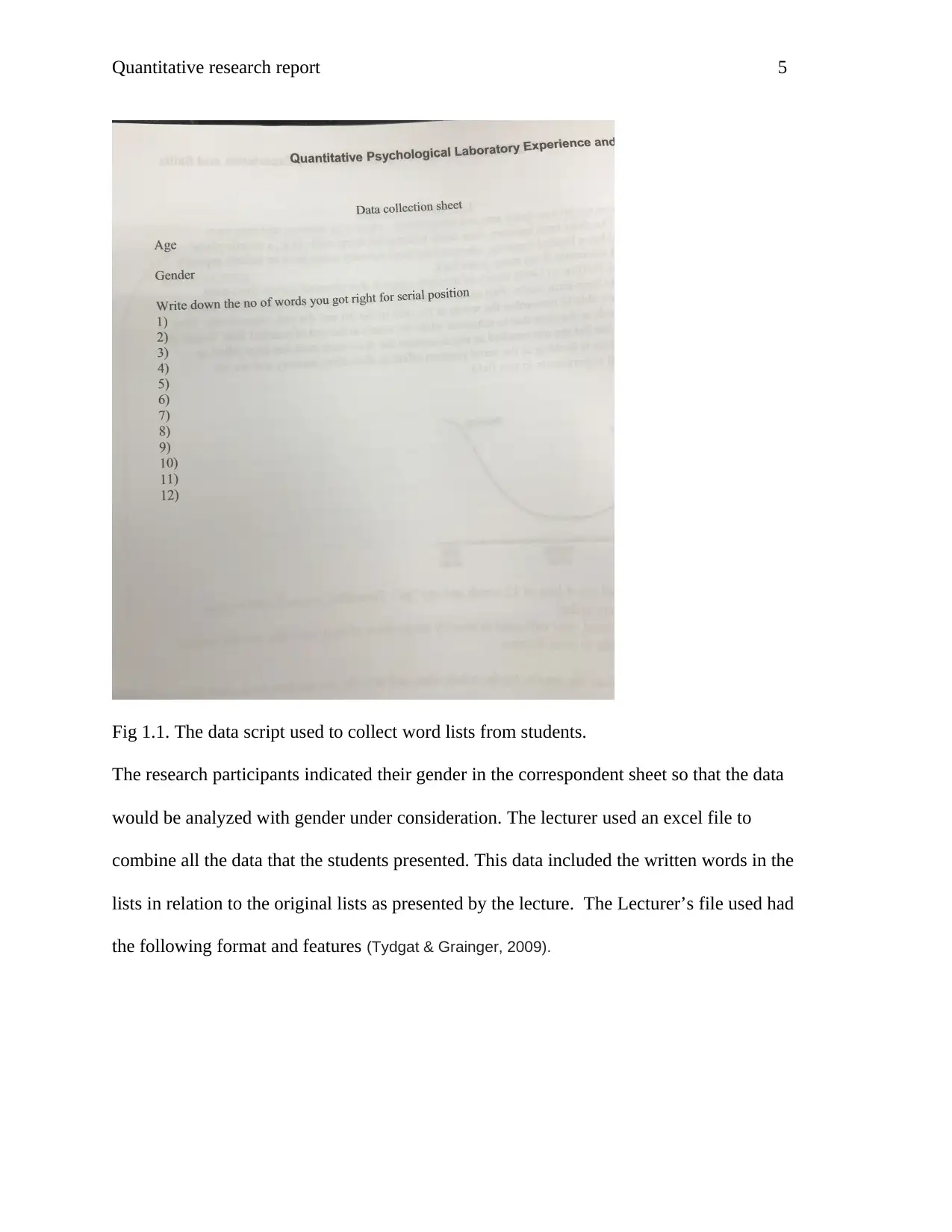
Quantitative research report 5
Fig 1.1. The data script used to collect word lists from students.
The research participants indicated their gender in the correspondent sheet so that the data
would be analyzed with gender under consideration. The lecturer used an excel file to
combine all the data that the students presented. This data included the written words in the
lists in relation to the original lists as presented by the lecture. The Lecturer’s file used had
the following format and features (Tydgat & Grainger, 2009).
Fig 1.1. The data script used to collect word lists from students.
The research participants indicated their gender in the correspondent sheet so that the data
would be analyzed with gender under consideration. The lecturer used an excel file to
combine all the data that the students presented. This data included the written words in the
lists in relation to the original lists as presented by the lecture. The Lecturer’s file used had
the following format and features (Tydgat & Grainger, 2009).

Quantitative research report 6
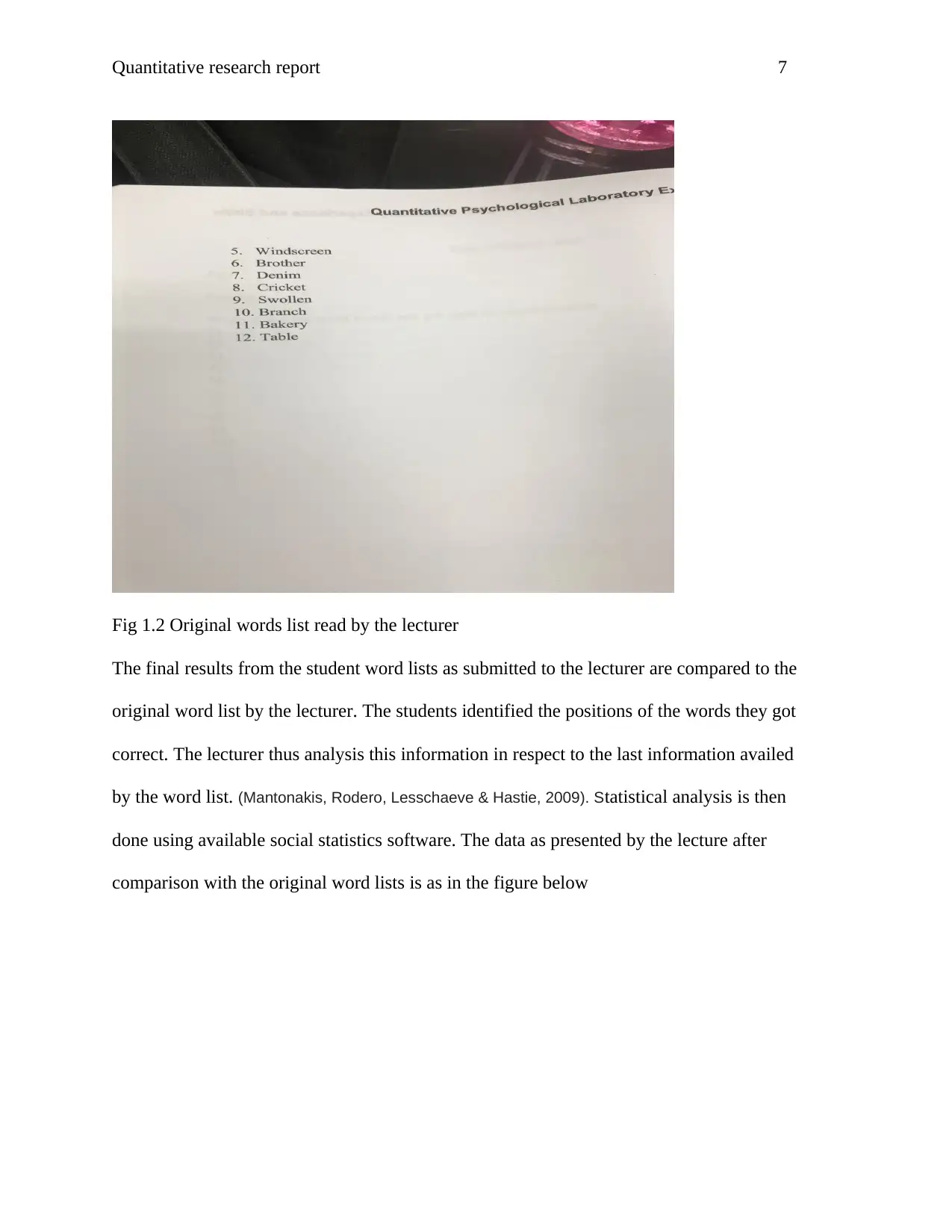
Quantitative research report 7
Fig 1.2 Original words list read by the lecturer
The final results from the student word lists as submitted to the lecturer are compared to the
original word list by the lecturer. The students identified the positions of the words they got
correct. The lecturer thus analysis this information in respect to the last information availed
by the word list. (Mantonakis, Rodero, Lesschaeve & Hastie, 2009). Statistical analysis is then
done using available social statistics software. The data as presented by the lecture after
comparison with the original word lists is as in the figure below
Fig 1.2 Original words list read by the lecturer
The final results from the student word lists as submitted to the lecturer are compared to the
original word list by the lecturer. The students identified the positions of the words they got
correct. The lecturer thus analysis this information in respect to the last information availed
by the word list. (Mantonakis, Rodero, Lesschaeve & Hastie, 2009). Statistical analysis is then
done using available social statistics software. The data as presented by the lecture after
comparison with the original word lists is as in the figure below
Paraphrase This Document
Need a fresh take? Get an instant paraphrase of this document with our AI Paraphraser
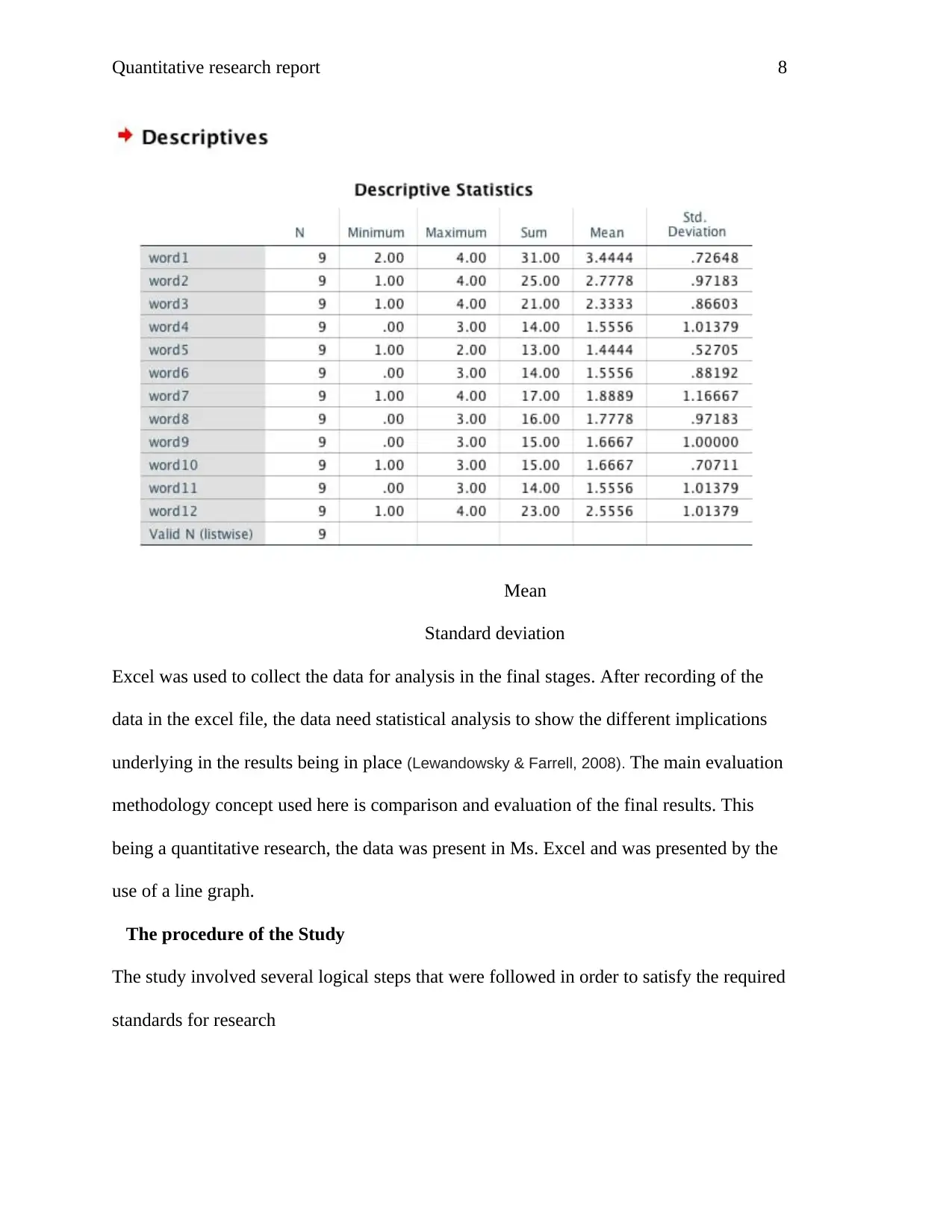
Quantitative research report 8
Mean
Standard deviation
Excel was used to collect the data for analysis in the final stages. After recording of the
data in the excel file, the data need statistical analysis to show the different implications
underlying in the results being in place (Lewandowsky & Farrell, 2008). The main evaluation
methodology concept used here is comparison and evaluation of the final results. This
being a quantitative research, the data was present in Ms. Excel and was presented by the
use of a line graph.
The procedure of the Study
The study involved several logical steps that were followed in order to satisfy the required
standards for research
Mean
Standard deviation
Excel was used to collect the data for analysis in the final stages. After recording of the
data in the excel file, the data need statistical analysis to show the different implications
underlying in the results being in place (Lewandowsky & Farrell, 2008). The main evaluation
methodology concept used here is comparison and evaluation of the final results. This
being a quantitative research, the data was present in Ms. Excel and was presented by the
use of a line graph.
The procedure of the Study
The study involved several logical steps that were followed in order to satisfy the required
standards for research
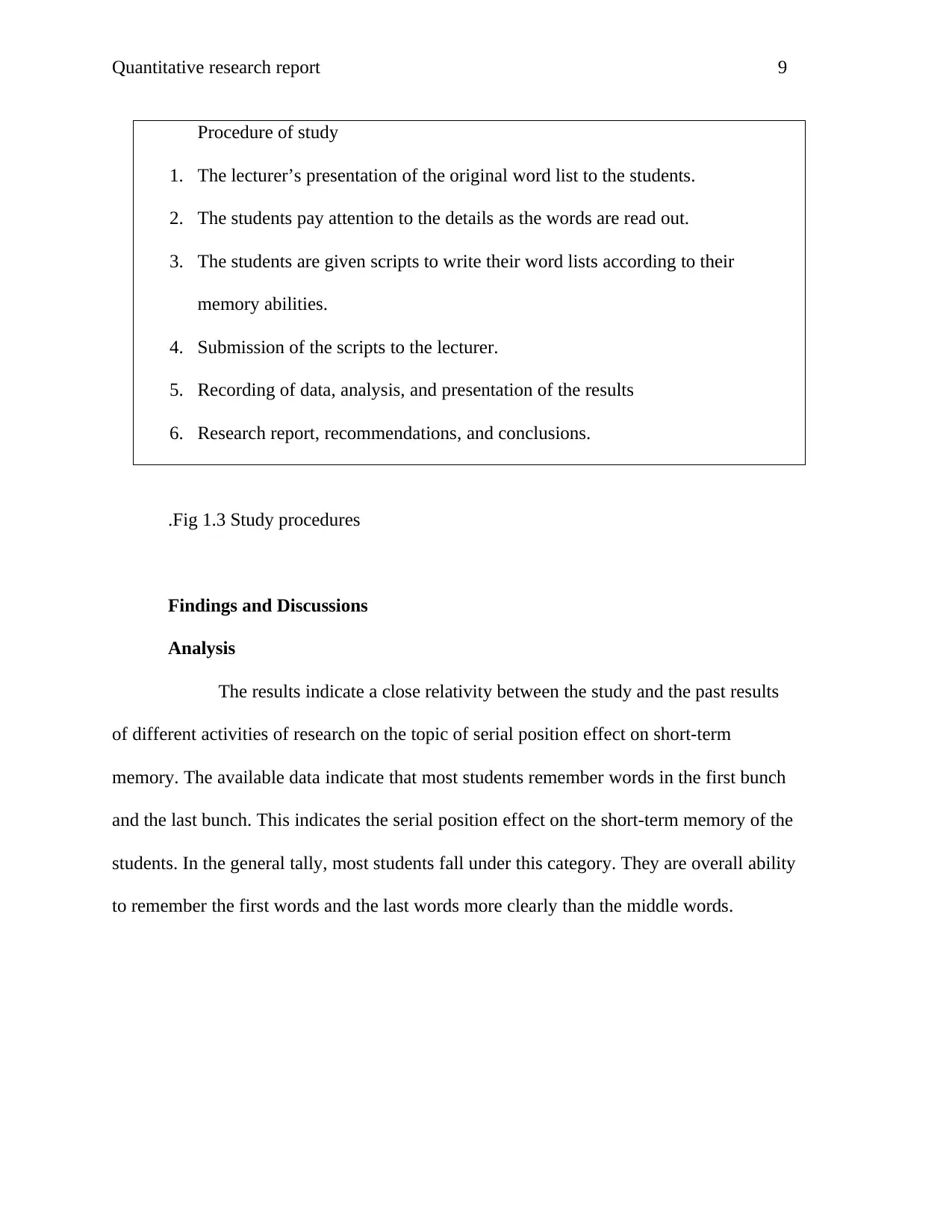
Quantitative research report 9
Procedure of study
1. The lecturer’s presentation of the original word list to the students.
2. The students pay attention to the details as the words are read out.
3. The students are given scripts to write their word lists according to their
memory abilities.
4. Submission of the scripts to the lecturer.
5. Recording of data, analysis, and presentation of the results
6. Research report, recommendations, and conclusions.
.Fig 1.3 Study procedures
Findings and Discussions
Analysis
The results indicate a close relativity between the study and the past results
of different activities of research on the topic of serial position effect on short-term
memory. The available data indicate that most students remember words in the first bunch
and the last bunch. This indicates the serial position effect on the short-term memory of the
students. In the general tally, most students fall under this category. They are overall ability
to remember the first words and the last words more clearly than the middle words.
Procedure of study
1. The lecturer’s presentation of the original word list to the students.
2. The students pay attention to the details as the words are read out.
3. The students are given scripts to write their word lists according to their
memory abilities.
4. Submission of the scripts to the lecturer.
5. Recording of data, analysis, and presentation of the results
6. Research report, recommendations, and conclusions.
.Fig 1.3 Study procedures
Findings and Discussions
Analysis
The results indicate a close relativity between the study and the past results
of different activities of research on the topic of serial position effect on short-term
memory. The available data indicate that most students remember words in the first bunch
and the last bunch. This indicates the serial position effect on the short-term memory of the
students. In the general tally, most students fall under this category. They are overall ability
to remember the first words and the last words more clearly than the middle words.
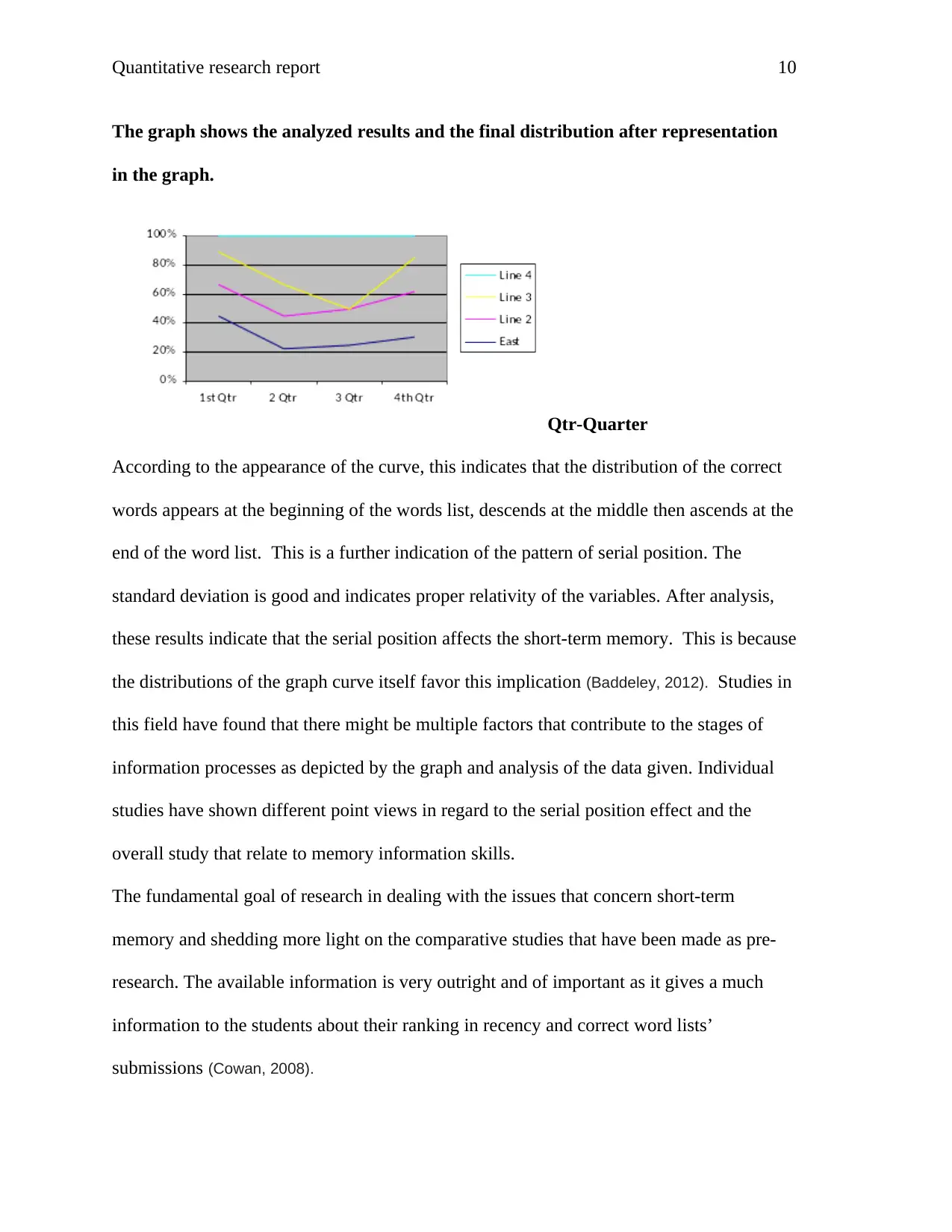
Quantitative research report 10
The graph shows the analyzed results and the final distribution after representation
in the graph.
Qtr-Quarter
According to the appearance of the curve, this indicates that the distribution of the correct
words appears at the beginning of the words list, descends at the middle then ascends at the
end of the word list. This is a further indication of the pattern of serial position. The
standard deviation is good and indicates proper relativity of the variables. After analysis,
these results indicate that the serial position affects the short-term memory. This is because
the distributions of the graph curve itself favor this implication (Baddeley, 2012). Studies in
this field have found that there might be multiple factors that contribute to the stages of
information processes as depicted by the graph and analysis of the data given. Individual
studies have shown different point views in regard to the serial position effect and the
overall study that relate to memory information skills.
The fundamental goal of research in dealing with the issues that concern short-term
memory and shedding more light on the comparative studies that have been made as pre-
research. The available information is very outright and of important as it gives a much
information to the students about their ranking in recency and correct word lists’
submissions (Cowan, 2008).
The graph shows the analyzed results and the final distribution after representation
in the graph.
Qtr-Quarter
According to the appearance of the curve, this indicates that the distribution of the correct
words appears at the beginning of the words list, descends at the middle then ascends at the
end of the word list. This is a further indication of the pattern of serial position. The
standard deviation is good and indicates proper relativity of the variables. After analysis,
these results indicate that the serial position affects the short-term memory. This is because
the distributions of the graph curve itself favor this implication (Baddeley, 2012). Studies in
this field have found that there might be multiple factors that contribute to the stages of
information processes as depicted by the graph and analysis of the data given. Individual
studies have shown different point views in regard to the serial position effect and the
overall study that relate to memory information skills.
The fundamental goal of research in dealing with the issues that concern short-term
memory and shedding more light on the comparative studies that have been made as pre-
research. The available information is very outright and of important as it gives a much
information to the students about their ranking in recency and correct word lists’
submissions (Cowan, 2008).
Secure Best Marks with AI Grader
Need help grading? Try our AI Grader for instant feedback on your assignments.
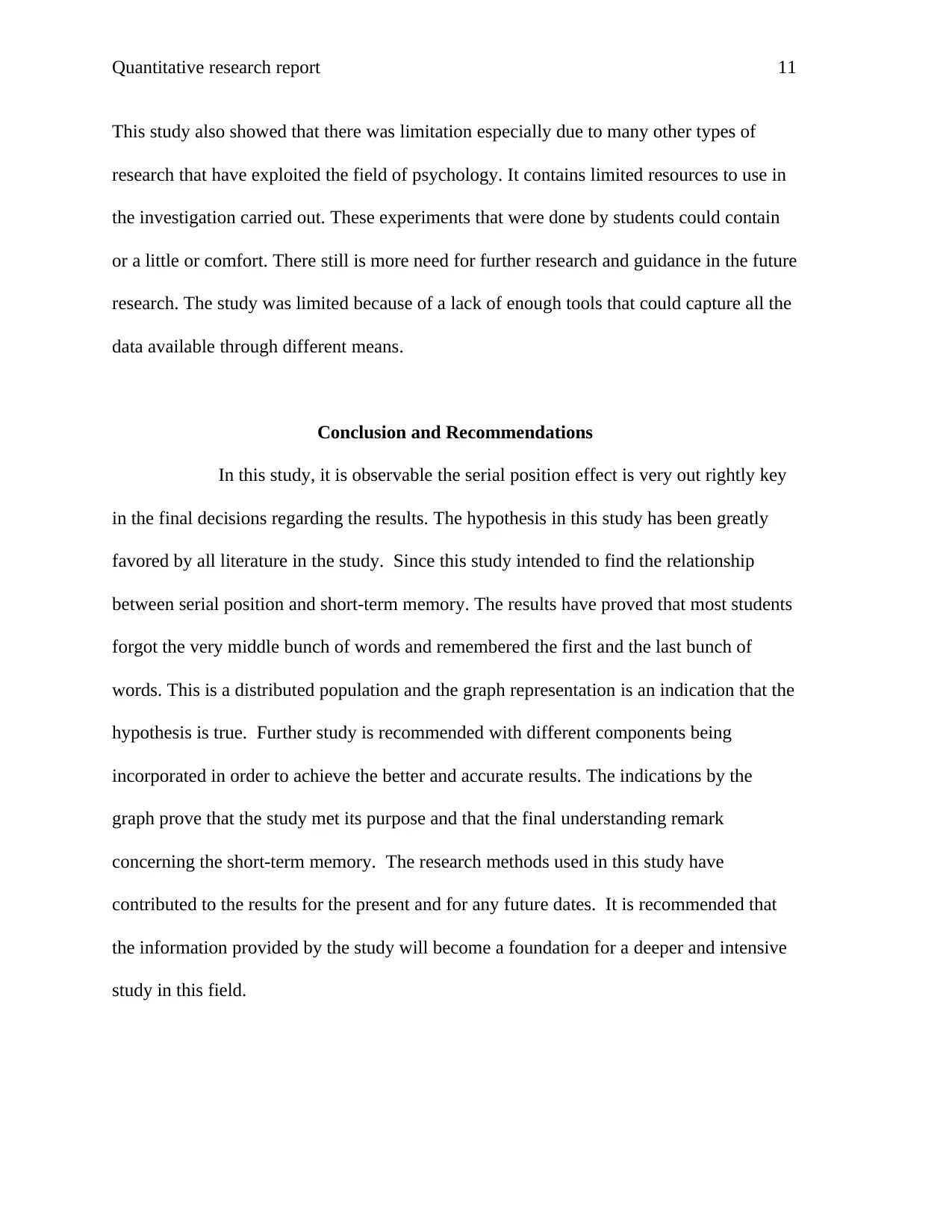
Quantitative research report 11
This study also showed that there was limitation especially due to many other types of
research that have exploited the field of psychology. It contains limited resources to use in
the investigation carried out. These experiments that were done by students could contain
or a little or comfort. There still is more need for further research and guidance in the future
research. The study was limited because of a lack of enough tools that could capture all the
data available through different means.
Conclusion and Recommendations
In this study, it is observable the serial position effect is very out rightly key
in the final decisions regarding the results. The hypothesis in this study has been greatly
favored by all literature in the study. Since this study intended to find the relationship
between serial position and short-term memory. The results have proved that most students
forgot the very middle bunch of words and remembered the first and the last bunch of
words. This is a distributed population and the graph representation is an indication that the
hypothesis is true. Further study is recommended with different components being
incorporated in order to achieve the better and accurate results. The indications by the
graph prove that the study met its purpose and that the final understanding remark
concerning the short-term memory. The research methods used in this study have
contributed to the results for the present and for any future dates. It is recommended that
the information provided by the study will become a foundation for a deeper and intensive
study in this field.
This study also showed that there was limitation especially due to many other types of
research that have exploited the field of psychology. It contains limited resources to use in
the investigation carried out. These experiments that were done by students could contain
or a little or comfort. There still is more need for further research and guidance in the future
research. The study was limited because of a lack of enough tools that could capture all the
data available through different means.
Conclusion and Recommendations
In this study, it is observable the serial position effect is very out rightly key
in the final decisions regarding the results. The hypothesis in this study has been greatly
favored by all literature in the study. Since this study intended to find the relationship
between serial position and short-term memory. The results have proved that most students
forgot the very middle bunch of words and remembered the first and the last bunch of
words. This is a distributed population and the graph representation is an indication that the
hypothesis is true. Further study is recommended with different components being
incorporated in order to achieve the better and accurate results. The indications by the
graph prove that the study met its purpose and that the final understanding remark
concerning the short-term memory. The research methods used in this study have
contributed to the results for the present and for any future dates. It is recommended that
the information provided by the study will become a foundation for a deeper and intensive
study in this field.
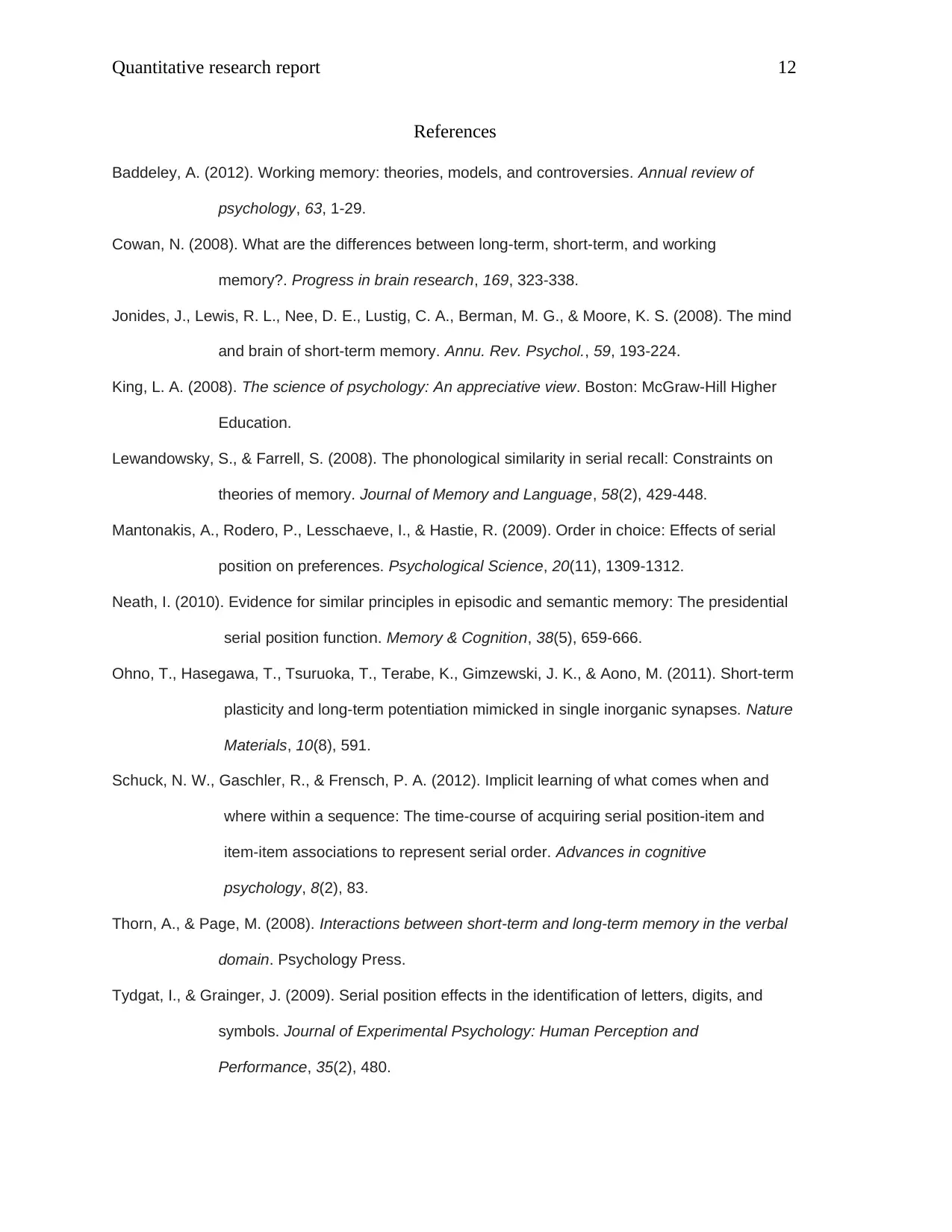
Quantitative research report 12
References
Baddeley, A. (2012). Working memory: theories, models, and controversies. Annual review of
psychology, 63, 1-29.
Cowan, N. (2008). What are the differences between long-term, short-term, and working
memory?. Progress in brain research, 169, 323-338.
Jonides, J., Lewis, R. L., Nee, D. E., Lustig, C. A., Berman, M. G., & Moore, K. S. (2008). The mind
and brain of short-term memory. Annu. Rev. Psychol., 59, 193-224.
King, L. A. (2008). The science of psychology: An appreciative view. Boston: McGraw-Hill Higher
Education.
Lewandowsky, S., & Farrell, S. (2008). The phonological similarity in serial recall: Constraints on
theories of memory. Journal of Memory and Language, 58(2), 429-448.
Mantonakis, A., Rodero, P., Lesschaeve, I., & Hastie, R. (2009). Order in choice: Effects of serial
position on preferences. Psychological Science, 20(11), 1309-1312.
Neath, I. (2010). Evidence for similar principles in episodic and semantic memory: The presidential
serial position function. Memory & Cognition, 38(5), 659-666.
Ohno, T., Hasegawa, T., Tsuruoka, T., Terabe, K., Gimzewski, J. K., & Aono, M. (2011). Short-term
plasticity and long-term potentiation mimicked in single inorganic synapses. Nature
Materials, 10(8), 591.
Schuck, N. W., Gaschler, R., & Frensch, P. A. (2012). Implicit learning of what comes when and
where within a sequence: The time-course of acquiring serial position-item and
item-item associations to represent serial order. Advances in cognitive
psychology, 8(2), 83.
Thorn, A., & Page, M. (2008). Interactions between short-term and long-term memory in the verbal
domain. Psychology Press.
Tydgat, I., & Grainger, J. (2009). Serial position effects in the identification of letters, digits, and
symbols. Journal of Experimental Psychology: Human Perception and
Performance, 35(2), 480.
References
Baddeley, A. (2012). Working memory: theories, models, and controversies. Annual review of
psychology, 63, 1-29.
Cowan, N. (2008). What are the differences between long-term, short-term, and working
memory?. Progress in brain research, 169, 323-338.
Jonides, J., Lewis, R. L., Nee, D. E., Lustig, C. A., Berman, M. G., & Moore, K. S. (2008). The mind
and brain of short-term memory. Annu. Rev. Psychol., 59, 193-224.
King, L. A. (2008). The science of psychology: An appreciative view. Boston: McGraw-Hill Higher
Education.
Lewandowsky, S., & Farrell, S. (2008). The phonological similarity in serial recall: Constraints on
theories of memory. Journal of Memory and Language, 58(2), 429-448.
Mantonakis, A., Rodero, P., Lesschaeve, I., & Hastie, R. (2009). Order in choice: Effects of serial
position on preferences. Psychological Science, 20(11), 1309-1312.
Neath, I. (2010). Evidence for similar principles in episodic and semantic memory: The presidential
serial position function. Memory & Cognition, 38(5), 659-666.
Ohno, T., Hasegawa, T., Tsuruoka, T., Terabe, K., Gimzewski, J. K., & Aono, M. (2011). Short-term
plasticity and long-term potentiation mimicked in single inorganic synapses. Nature
Materials, 10(8), 591.
Schuck, N. W., Gaschler, R., & Frensch, P. A. (2012). Implicit learning of what comes when and
where within a sequence: The time-course of acquiring serial position-item and
item-item associations to represent serial order. Advances in cognitive
psychology, 8(2), 83.
Thorn, A., & Page, M. (2008). Interactions between short-term and long-term memory in the verbal
domain. Psychology Press.
Tydgat, I., & Grainger, J. (2009). Serial position effects in the identification of letters, digits, and
symbols. Journal of Experimental Psychology: Human Perception and
Performance, 35(2), 480.

Quantitative research report 13
Weigelt, M., Rosenbaum, D. A., Huelshorst, S., & Schack, T. (2009). Moving and memorizing:
Motor planning modulates the recency effect in serial and free recall. Acta
Psychologica, 132(1), 68-79.ss
Weigelt, M., Rosenbaum, D. A., Huelshorst, S., & Schack, T. (2009). Moving and memorizing:
Motor planning modulates the recency effect in serial and free recall. Acta
Psychologica, 132(1), 68-79.ss
1 out of 13
Related Documents
Your All-in-One AI-Powered Toolkit for Academic Success.
+13062052269
info@desklib.com
Available 24*7 on WhatsApp / Email
![[object Object]](/_next/static/media/star-bottom.7253800d.svg)
Unlock your academic potential
© 2024 | Zucol Services PVT LTD | All rights reserved.





